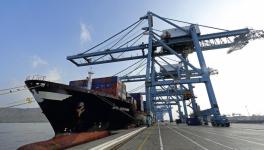Why Separation of Exchange Rate Depreciation from Real Wages Makes for Flawed Analysis

Representational use only.Image Courtesy:pix4free
Most people, including even trained economists, fail to appreciate the fact that an exchange rate depreciation, if it is to work in reducing the trade deficit in a capitalist economy, must necessarily hurt the working class by lowering the real wage rate. A capitalist economy, looking at it differently, improves its trade balance, for which it must improve its competitiveness, by lowering the real wage rate; and an exchange rate depreciation is one way of doing so.
Most textbooks in economics do not mention this fact. They are written from the point of view not only of bourgeois economics in general, but of bourgeois economics that invokes a model of a capitalist economy that is far removed from reality. They see this economy as consisting of a set of markets in each of which a price-rise is supposed to lower excess demand. The foreign exchange market is one such; and the textbooks simply say that as long as the demand and supply curves have the right shape in this market (so that excess demand is lowered through a price-rise), an exchange rate depreciation, which is the same as a rise in the price of foreign exchange, lowers the excess demand for foreign exchange, namely lowers the trade deficit. This is where their analysis of an exchange rate depreciation usually ends; and then they move on to discussing under what conditions the curves have the right shape.
This entire mode of analysis however is flawed. Most economies need imported inputs, usually oil and natural gas; the oil-producing economies on the other hand need a range of non-oil raw materials which they cannot grow themselves but cannot do without. The imported inputs, together with labour and domestically-produced current inputs, constitute the list of current inputs. And in all capitalist economies, the prices of commodities are determined as a mark-up over the costs of current inputs per unit of output. This is of course true under monopoly capitalism. This is how oligopolists operate; they fix prices in this manner and let the level of demand at this price determine what is produced. Some argue that capitalism even in the earlier period was characterised by such price-fixing, and that the classical political economists’ conception of free competition (which Marx took over) where the producers accepted a price impersonally determined by the market, was not a realistic picture. But this discussion is not germane to the present issue; the basic point here is that in any modern economy, prices are fixed by oligopolists as a mark-up over the unit prime cost.
Now, suppose a currency depreciates by 10%; then the local currency prices of all imported inputs go up by 10%, and therefore the part of unit cost arising from imported inputs in the production of any final good goes up by 10%. If real wages were to remain unchanged, then money wages will have to keep going up proportionately as prices rise; and in such a case, prices will ultimately rise by 10% in local currency, with money wages also rising by 10% and hence unit labour cost too also rising by 10%. (The unit prime cost arising from domestically-produced inputs rises in the same ratio as the final produced goods price and therefore will also rise, automatically, by 10%). But if local currency prices rise by 10% following an exchange rate depreciation of 10%, then this means there has been no real effective depreciation whatsoever; and hence not an iota of difference will be made to the trade deficit.
If domestic prices rise by 10% following an exchange rate depreciation of 10%, then the prices of export goods in terms of foreign currency would remain unchanged; and hence there is no question of any increase in the quantity of exports owing to their becoming cheaper. Likewise, if domestic prices rise by 10% following an exchange rate depreciation of 10%, then the local currency price of imported goods would rise by 10%, the same as domestically produced goods, in which case there is no question of any reduction in the quantity of imports. It follows therefore that with no increase in the quantity of exports and no decrease in the quantity of imports, the trade deficit measured in foreign currency remains unchanged.
An absolutely essential condition for an exchange rate depreciation to work therefore (and this is only a necessary condition with no guarantee that its fulfilment will actually improve the trade balance) is that domestic prices must not rise at the same rate as the price of foreign exchange owing to an exchange rate depreciation. And this can happen only if money wages do not rise by the same proportion as the final goods prices; that is, if there is a fall in the real wage rate.
This can be seen as follows. If, say, a 10% exchange rate depreciation is to make any difference to the trade balance, then the domestic prices must rise by less than 10%, say, by 7%, for only then would there be some real effective depreciation. For this to happen, the unit prime cost must rise by 7%, as the markup by the capitalists is a given ratio. Now, the unit prime cost has two relevant components: the unit labour cost and the unit imported-input cost (unit home-produced input cost rises in the same ratio as the final goods price and therefore need not be considered separately here). Therefore, for the unit prime cost to rise by 7%, since the unit imported-input cost rises by 10%, the unit labour input cost must rise by less than 7%, say by 5%. With given labour coefficients in production this can happen only if money wages rise by 5%, when prices rise by 7%; that is, when real wages fall.
Of course, there can be real effective exchange rate depreciation, with domestic prices rising by less than the 10% rise in the price of foreign exchange, even with real wages remaining unchanged, if the profit margins of the capitalists could be lowered. But this is precisely what is not possible in a capitalist economy. This can happen in a socialist economy where the enterprises, mostly State-owned, can be directed to charge lower profit margins, so that a real effective exchange rate depreciation can be brought about with no fall in the real wage rate; but in a capitalist economy, the profit-margin is not amenable to any reduction. A real effective exchange rate depreciation therefore necessarily imposes a squeeze on the real wage.
But even assuming that the workers are not strong enough to resist such a reduction in their real wage rate, there is no reason to expect the trade balance to improve: if the trade balance is to improve then domestic employment and output will increase, but this would mean a reduction in output and employment in some other countries at whose expense this economy would be increasing its market-share. If those countries retaliate by depreciating their exchange rates in the same proportion, then there would be no change in market shares and no change in trade balances either.
When the competing countries depreciate their exchange rates in retaliation, the real wages go down in those countries as well. This mode of reducing trade deficit therefore, when no country is making any independent effort to raise the level of demand through income redistribution in favour of the workers or through larger government expenditure, simply results in each squeezing its workers to no avail.
The attempt to raise domestic employment at the expense of rivals, through an exchange rate depreciation (that is supposed to work through reducing the trade deficit) is called a “beggar-my-neighbour” policy. The pursuit of “beggar-my-neighbour” policies by several capitalist economies raises employment nowhere while reducing the real wage rate everywhere.
But that is not all. The reduction in real wages can, under certain circumstances, even lead to a reduction in employment everywhere because of the associated reduction in aggregate demand. It is a symptom of the irrationality of capitalism that a group of countries vying with one another to improve their positions by pursuing “beggar-my-neighbour” policies, may ultimately end up with each country becoming worse off than before.
It is a sign of the hopelessness induced by the current capitalist crisis, that, notwithstanding the experience of the 1930s, voices are audible in the US today which seek a revival of the US economy through a depreciation of the dollar.
Get the latest reports & analysis with people's perspective on Protests, movements & deep analytical videos, discussions of the current affairs in your Telegram app. Subscribe to NewsClick's Telegram channel & get Real-Time updates on stories, as they get published on our website.
























